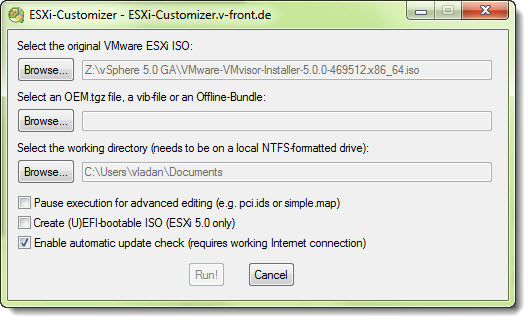Recently updated in Webinar about what's new in the free virtualization tools landscape. Over time, older free tools disappear and new free tools are launched. In many cases the newer tools are better and more innovative but, on the other hand, there are always free tools that are the de facto standard for that task.
There are well over 50 free tools available for vSphere, but I'm not covering all of them here. Instead, here are some of the more interesting new ones recently released for vSphere and Fusion.
 Nick Weaver's Uber Network Fuser -- This is the virtual network editor that's missing from VMware Fusion on the Mac. I tried it in my lab and showed how it
Nick Weaver's Uber Network Fuser -- This is the virtual network editor that's missing from VMware Fusion on the Mac. I tried it in my lab and showed how it works in this video I just posted on my Website. If you want to try it for yourself, download the Uber Network Fuser here.
 Nick Weaver's UberAlign -- UberAlign comes as a two-piece tool made up of a virtual appliance server and a Windows GUI client. The tool is used to align virtual machine disk files of both Windows and Linux VMs. By properly aligning virtual disk files that were mis-aligned, you can gain significant performance. Nick's tool is on the scale of an expensive commercial tool with its virtual appliance, remote console, and support for multiple simultaneous alignments across multiple virtual machines at the same time. For more information, read about and download UberAlign here and watch some of Nick's how-to videos on how to use it.
Nick Weaver's UberAlign -- UberAlign comes as a two-piece tool made up of a virtual appliance server and a Windows GUI client. The tool is used to align virtual machine disk files of both Windows and Linux VMs. By properly aligning virtual disk files that were mis-aligned, you can gain significant performance. Nick's tool is on the scale of an expensive commercial tool with its virtual appliance, remote console, and support for multiple simultaneous alignments across multiple virtual machines at the same time. For more information, read about and download UberAlign here and watch some of Nick's how-to videos on how to use it.Solarwinds VM-to-Cloud Calculator -- This Solarwinds tool compares the cost of moving to the cloud across multiple providers including Rackspace, Amazon EC2, and Windows Azure.
 ESXi Customizer -- Allows you to customize the VMware ESXi 5 installation ISO to include drivers that are not originally included. Start customizing here.
ESXi Customizer -- Allows you to customize the VMware ESXi 5 installation ISO to include drivers that are not originally included. Start customizing here. vKernel vSCOPE -- A virtual appliance that analyzes your virtual infrastructure and tells you whick virtual machines have performance issues using a heatmap where the VMs with the greatest problems rise to the top. Look for those hotspots now by clicking here.
vKernel vSCOPE -- A virtual appliance that analyzes your virtual infrastructure and tells you whick virtual machines have performance issues using a heatmap where the VMs with the greatest problems rise to the top. Look for those hotspots now by clicking here.  ESX System Analyzer -- From VMware labs, ESX System Analyzer is used to help you plan a migration from ESX to ESXi. It analyzes information like hardware compatibility, registered VMs, any modifications to the service console, and environmental summary information.
ESX System Analyzer -- From VMware labs, ESX System Analyzer is used to help you plan a migration from ESX to ESXi. It analyzes information like hardware compatibility, registered VMs, any modifications to the service console, and environmental summary information. I/O Analyzer -- Here's another one from VMware labs, I/O Analyzer is a virtual appliance that measures storage performance.
I/O Analyzer -- Here's another one from VMware labs, I/O Analyzer is a virtual appliance that measures storage performance.A couple of notes: VMware Labs has 30+ free tools with many of them being released or updated in the last six months. Also, Kendrick Coleman has a list of just about all the free tools you'll find for vSphere on the Web. You can also check out the "Top Free vSphere Tools" Webinar we hosted recently, posted here.




















